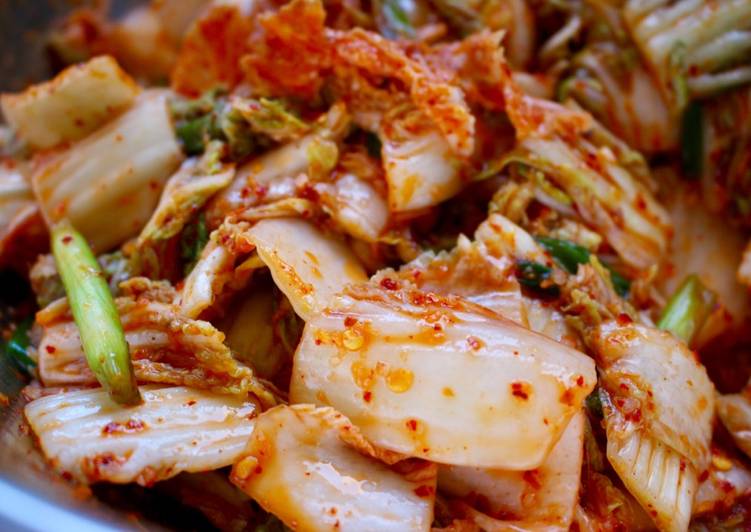
Hey everyone, it’s me again, Dan, welcome to my recipe site. Today, we’re going to make a distinctive dish, kimchi (easier than you think! ;) ). One of my favorites food recipes. For mine, I will make it a bit tasty. This will be really delicious.
Great recipe for Kimchi (Easier than you think! ;) ). If you're intimidated by the idea of making your own kimchi, my recipe is exact, reliable, small enough, and tasty enough that you won't regret the effort. Plus it uses what are likely more accessible ingredients - fish sauce, - crushed.
Kimchi (Easier than you think! ;) ) is one of the most popular of recent trending meals on earth. It is enjoyed by millions every day. It’s simple, it’s fast, it tastes delicious. They’re nice and they look fantastic. Kimchi (Easier than you think! ;) ) is something which I have loved my whole life.
To get started with this recipe, we have to first prepare a few ingredients. You can cook kimchi (easier than you think! ;) ) using 11 ingredients and 9 steps. Here is how you cook that.
The ingredients needed to make Kimchi (Easier than you think! ;) ):
- Make ready 4-5 pounds Napa cabbage, cut into roughly 1"x 2" pieces (about 30 cups of chopped raw cabbage)
- Prepare 1 bunch green onions, washed, roots trimmed, and cut into 2 inch segments
- Prepare 5 Tablespoons kosher salt (about 10% less if you're using regular table salt)
- Get For the paste:
- Make ready 1/4 cup minced garlic (about 5 or 6 large cloves)
- Take 1/4 cup minced fresh ginger root (about a 2" segment, peeled)
- Make ready 1/4-1/2 cup crushed red chili flakes depending on how hot you want your kimchi. See notes above re: gochugaru
- Get 1/4 cup steamed white rice, lightly packed. Short or long grain is fine. If stale, microwave with 2 Tbsp. water for 1 minute
- Take 1/4 cup fish sauce
- Take 1/4 cup sugar
- Get 1/4 cup water for blending + 1/3 cup water for rinsing seasoning from bowl (see directions below)
This makes for a fairly ginger-forward kimchi, so adjust the amount according to your preferences. Chock full of vitamins and pro-biotics, this mak kimchi is the perfect healthy side dish for any Korean meal. Good authentic homemade kimchi is much easier than you think. Making good authentic kimchi at home is much easier than you think.
Steps to make Kimchi (Easier than you think! ;) ):
- In a large stainless steel or mixing bowl, toss the raw cabbage, green onion, and the salt together to pre-brine the cabbage. Make sure to thoroughly incorporate the salt throughout the cabbage. In 10 to 15 minutes, you should start to see the cabbage leach liquid and wilt. Let the cabbage sit for 1.5 to 2 hours, tossing and redistributing every 30 minutes to ensure even brining.
- After at least 90 minutes of pre-brining, rinse the cabbage with enough water to cover the cabbage by 4 or 5 inches by swishing the cabbage in the water 7 or 8 times. Remove the cabbage into a strainer and let the excess water drain while you prepare the paste.
- Make the paste by putting all the paste ingredients into a blender and blend until you can't see the individual grains of rice. Pour the paste over the cabbage.
- Get into the bowl with your hands and mix the paste into the cabbage until all the pieces are evenly and thoroughly coated.
- Pack your kimchi into a clean, dry bottle or other tight-lidded container (this time I repurposed a half gallon kimchi jar) and use the last 1/3 cup of water to swish around the mixing bowl, pick up all the remaining paste, and pour that liquid on top of your kimchi. Remember to leave 2 to 3 inches of headspace at the top to allow for expansion as fermentation takes place.
- Your batch of kimchi is now ready for fermentation in a dark but not cold place like the inside of your cupboard. Or, if you can find a warmish spot in your garage, you can put it there. (I know that's not always possible for cold climate people in the middle of winter.) As it ripens, it's a good idea keep the lid slightly unscrewed to relieve the pressurization caused by fermentation. (Your jar can literally explode from the pressure on a specially active fermentation day.)
- People often ask HOW RIPE DOES THE KIMCHI HAVE TO BE BEFORE I REFRIGERATE OR EAT IT? You can eat the kimchi whenever you want. Fresh, just after it's been made, all the way up to when it's so incredibly old, ripe and stinky you could choke out a subway system by placing an open jar in one of the vents. It remains safe for human consumption for A VERY LONG TIME.
- But as to when to refrigerate, just go out once a day every day to taste a piece, and when it gets to the ripeness you like, stick it in the fridge. It'll continue to ripen, but very slowly.
- Enjoy! :)
This list has something for everyone and every season! In late fall, Korean households make a large batch of traditional napa cabbage kimchi (배추), also called pogi kimchi (포기김치), to last through the winter and early spring. Making kimchi is easier than you would think Granny Choe lays out kimchi ingredients: Nappa cabbage, onions, mustard greens, daikon, ginger, garlic, chile powder, sugar, salt. Machine Project hosts some of the best food events, usually at really affordable prices. Two fermented foods—sauerkraut and kimchi—are especially good additions to your rotation that have plenty in common (though some easy to spot differences, too).
So that is going to wrap this up with this special food kimchi (easier than you think! ;) ) recipe. Thank you very much for your time. I am confident that you can make this at home. There is gonna be interesting food in home recipes coming up. Don’t forget to save this page in your browser, and share it to your family, colleague and friends. Thanks again for reading. Go on get cooking!

